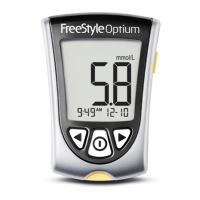Table of Contents
Welcome 1
1 Important Things to Know about
Your Optium Xceed Diabetes
Monitoring System 3
Intended Use 3
How Your Optium Xceed Diabetes
Monitoring System Works 4
Optium Xceed Kit Contents 5
Getting to Know Your Monitor’s Features 6
2 Setting Up Your Optium Xceed Monitor 9
Buttons to Use 9
Setup Options 9
How to Set the Beeper, Date, Time, & Measurement Units 11
Set Beeper 11
Set Time 13
Set Date 15
Set Time Format 18
Set Date Format 19
Set Blood Glucose Measurement Units 20
3 Calibrating Your Optium Xceed Monitor 22
Why Calibrate Your Monitor? 22
When to Calibrate Your Monitor 22
What You Will Need 23
How to Calibrate Your Monitor 23
How to Recall the LOT Number or Calibration CODE 28
4 Monitoring Your Blood Glucose 30
What You Will Need 30
Important Information about Monitoring
Your Blood Glucose 30
How to Monitor Your Blood Glucose 31
Understanding Your Result 39
5 Monitoring Your Blood ß-Ketone 43
What You Will Need 43
Important Information about Monitoring
Your Blood ß-Ketone 44
How to Monitor Your Blood ß-Ketone 45
Understanding Your Result 52

